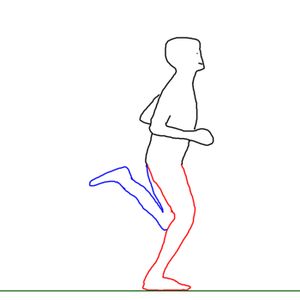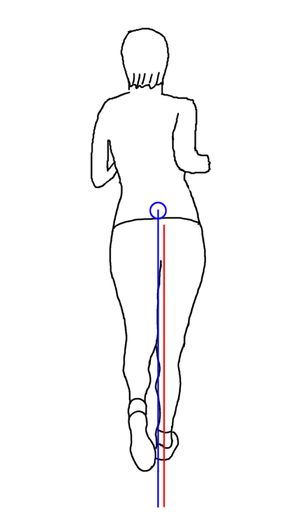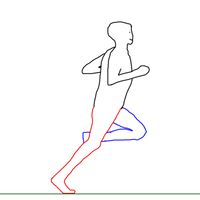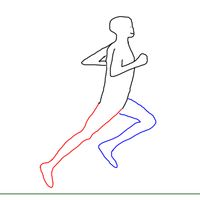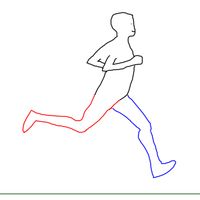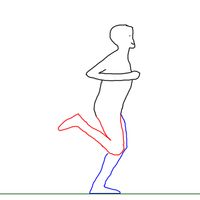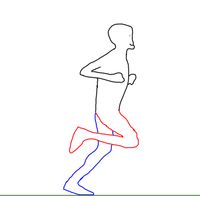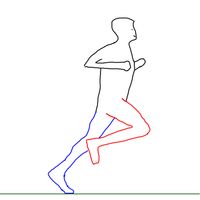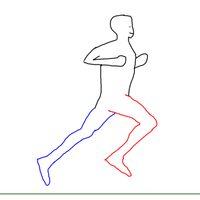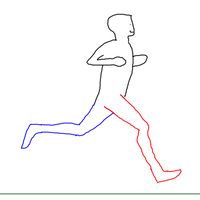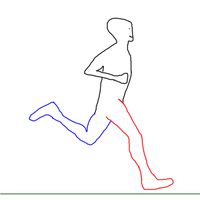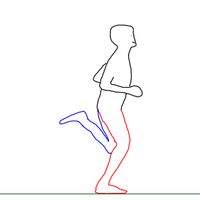Running Form
The science behind running form is limited, but there are several aspects to running form that are generally recommended. This article covers some key components of running form, including a high Cadence, avoiding Overstriding and the need for a slight forward lean.
Contents
1 Running Form
1.1 Cadence
Main article: Cadence
Cadence, which is how often your feet touch the ground, is reasonably easy to modify and has a large impact on running form and running efficiency. You should aim for a cadence of around 180 steps/minute counting both feet, which is 90 steps/minute if you count just one foot. Initially this is likely to feel strange at first, like your shoes are tied together, but after a few weeks it will become natural. A metronome can help you keep time, as can music remixed to 180 BPM or a sports watch with a Footpod.
1.2 Overstriding
Main article: Overstriding
The picture below is an example of a common problem called overstriding. With overstriding, the foot lands ahead of the hips, which tends to cause braking forces and exacerbates heel strike.
1.3 Forward Lean
The image below shows the slight forward lean of the body, putting the weight over the front of the foot. An easy way to get a sense of the right lean is to stand up naturally, then gently lean forward. You should feel your weight change from being over all of your feet equally to being over the front part of your foot, but don't lean so far forward that you are on your toes with your heels off the ground. This is the feeling you should have when running. Another way of getting a sense of the forward lean is to stand up tall, then lean forward until you have to start running to avoid falling over.
1.3.1 The Forward Lean and Gravity
The Pose method and Chi Running both talk about using gravity to pull you forward. While this is obviously nonsense from the perspective of the laws of physics, there is some basis for the idea. The forward lean does not cause gravity to "pull you along", but it does change the vector of the force your muscles are applying to your feet. If you are perfectly upright, your muscles are pushing down, with little or none of the force being directed backward to provide propulsion. As you lean forward, your muscles start to push both down and backwards, providing greater forward propulsion. It is possible to increase your speed by increasing your forward lean. Your muscles are still providing the propulsion, not gravity, but the extra forward lean does vector the muscular force better.
1.4 Run Tall
The back should be straight, without any hunching over or bending, but also without being rigid. A mental exercise to improve this is to imagine that there is a thread attached to the top of your head while you're running, and the thread is pulling you taller. If you look further ahead rather than down at your feet, this will help with your back angle as well as preventing excess strain on your neck.
1.5 Arm Position
Main article: Arm Position
A high cadence will naturally keep your arms high.Your arms should swing naturally, acting as a counterbalance to your running motion. You don't need to consciously drive your arms; just let them move naturally and freely. Your shoulders should be relaxed rather than hunched up. You may need to check for tension in your shoulders periodically and consciously relax them.
1.6 Foot Strike
Main article: Foot Strike
Foot strike is which part of the foot lands first while running. Some runners land on their heels while others land on their forefoot. The optimal foot strike is controversial and there is insufficient evidence to make any clear recommendations. My recommendation is to focus on Cadence and reducing overstriding rather than changing your foot strike.
1.7 Step width
Most runners will naturally run with their feet landing close to the midline of their body. One study showed that runners generally prefer to have their feet land about 1.4 inches (3.6cm) from the midline, and changing to a wider landing pattern increased the energy cost of running by up to 11%[1]. This is probably not something that most runners need to worry about, but there are small percentages that have an unusually wide step width. This may be due to have a large muscle or fat mass on the inner thighs that interferes with leg movement, in which case compression clothing may help.
2 Listen to Your Feet
The sound your feet make when they land can tell you a lot about your running form.
- The pat. A good running form will have a sound like your feet are gently patting the ground. Generally speaking, the quieter your feet land the better.
- The scrape. If you hear a scraping sound it means your feet are still moving horizontally when they touch down. If you hear this scraping sound, try to feel with your feet if your foot is pushing forward against the ground on contact or backwards. The most common situation is that your feet are pushing forward due to Overstriding.
- The slap. A hard slapping sound often indicates a high impact is occurring. This can occur for various reasons, and it's best to get someone to watch your running form or use High Speed Video Analysis.
- Symmetry. Your feet should sound the same, nds any difference indicates an imbalance that should be corrected. This imbalance could be in flexibility, strength, leg length or some other factor.
3 Changing your running form
While an improved running form is likely to improve your efficiency and reduce your overall risk of injury, the change to get to an improved form creates an injury risk. Your body has adapted to the way you currently run, and the change will create new stresses that you will need to adjust to. The more experienced you are and the higher your mileage, the greater the risk. This is because a change in running style is compounded by the miles you spend in the new style. Someone who runs 20 miles/day has 10 times the stress from a change compared with someone running 2 miles/day. The more experienced you are, the more your body will have adapted to being strong in the way you currently run. Therefore you should make any changes gradually and possibly reduce your mileage.
4 Analyzing Running Form
The simplest way of having your running form analyzed is to get someone to watch you run. However, the movements of running occur quickly and it's tricky for even the most experienced person to catch the details. High Speed Video Analysis is a far better option and can be done reasonably cheaply.
5 Running Movements
The images below show the sequence of movements that make up running, along with notes describing the action and muscles involved[2]. The descriptions focus on the right leg, shown in red and show a complete cycle.
- Running Form
6 References
- ↑ CJ. Arellano, R. Kram, The effects of step width and arm swing on energetic cost and lateral balance during running., J Biomech, volume 44, issue 7, pages 1291-5, Apr 2011, doi 10.1016/j.jbiomech.2011.01.002, PMID 21316058
- ↑ S. Ounpuu, The biomechanics of walking and running., Clin Sports Med, volume 13, issue 4, pages 843-63, Oct 1994, PMID 7805110

